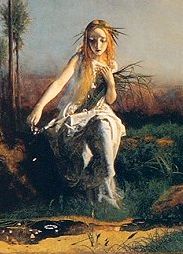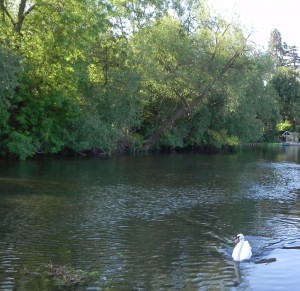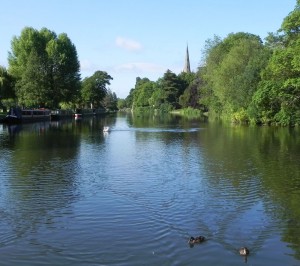I’ve never had a lot of time for the myths and legends that surround Shakespeare’s life, many of which probably sprung up in order to satisfy the curiosity of visitors wanting to find out more about the man. I’ve always assumed the supposed inspiration for the drowning of Ophelia in Hamlet to be one of those, a story without any real evidence to support it. But on this sunny spring morning I took a walk up the Avon in search of a willow growing askant this stretch of river.
Why the change of mind? I recently re-read Edgar Fripp’s book Shakespeare’s Haunts near Stratford, published in 1929. Fripp spent years searching the documentary records of the town and local area for people and events that might have been known to Shakespeare. He reports this story, and Samuel Schoenbaum repeats in his own book Shakespeare’s Lives. It runs that a young woman drowned in the Avon, near the village of Tiddington, a mile or so up the river from Stratford, on 17 December 1579. The records of the inquest still exist. The coroner, the Town Clerk of Stratford, agreed that the deceased “Going with a milk-pail to draw water at the river, standing on the bank, slipped and fell in, and was drowned”. The inquest established that her death was a simple accident, not a case of suicide. The circumstances find a strong echo in the description of Ophelia’s watery death in Hamlet.
There is a willow grows askant a brook,
That shows his hoar leaves in the glassy stream;
There with fantastic garlands did she come: ….
There, on the pendent boughs her coronet weeds
Clambering to hang, an envious sliver broke;
When down her weedy trophies and herself
Fell in the weeping brook.
At the coroner’s inquest it was important to establish whether the death was a simple accident or a case of suicide. In the Tiddington drowning the body was taken up from its temporary grave for examination, and if the verdict had been suicide she would have been reburied in unconsecrated land and denied a Christian burial.
Gertrude describes Ophelia’s death as an accident too, but the gravediggers gossip about the rumours:
2nd Gravedigger: Is she to be buried in Christian burial when she wilfully seeks her own salvation?
1st Gravedigger: I tell thee she is. Therefore make her grave straight. The crowner hath sat on her, and finds it Christian burial.
They go on to talk about the meaning of suicide by drowning:
It must be se offendendo. It cannot be else. For here lies the point: if I drown myself wittingly, it argues an act … Here lies the water – good. Here stands the man – good. If the man goes to this water and drown himself, it is, will he, nill he, he goes, mark you that. But if the water come to him and drown him he drowns not himself.
There are plenty of willows growing along the river in and near Stratford, just as there are along many of England’s rivers. Sadly for me, though, the willows are now regularly cut back in order to keep the banks tidy and the river clear for the many boats that use it, so the photo, taken upstream of the town, is the best view I was able to find.
Fripp and Schoenbaum are keen not to assume too much for this story, but the 15-year old William Shakespeare would have heard it and it could have come to mind years later. The name of the girl who drowned, in a spooky coincidence, was Katherine Hamlet.





Another contender for the inspiration for Ophelia emerged today . According to an item on the 8 o’clock news on BBC Radio 4 this morning, an Oxford academic researching 16th century coroners’ reports at the National Archives has found a record of the drowning a two-year old girl, Jane Shaxspere, in 1569 – she had been picking flowers by a pond at Upton Warren near Bromsgrove in Worcestershire and drowned after falling in.
http://www.bbc.co.uk/news/mobile/education-13682993
http://www.guardian.co.uk/culture/2011/jun/08/shakespeare-real-ophelia-link
Thanks for this comment. See my reply to John Taplin who has also made the same point. The Herald is running a story on this tomorrow!
Sylvia, you may find this following recent discovery by Dr. Steve Gunn, my son’s old Oxford tutor, also of interest in regard to a possible alternative candidate for Ophelia. There is, of course, the ‘legend’ of Margaret Clopton who supposedly drowned in the spring by Clopton House. http://www.bbc.co.uk/news/education-13682993
Best wishes
John (ex-Nash’s)
Thanks John. I’ve been in touch with Dr Gunn today following the piece on Radio 4 this morning providing him with the link to my blog. The Stratford Herald are also going to run a piece on this. Am I right in thinking that there is no evidence for the Clopton story?
There is no empirical evidence for the supposed drowning of Margaret Clopton in a spring or well at Clopton House, though unlike the other story concerning a tragic Clopton girl’s death, that of a Charlotte Clopton said to have been buried alive in the Clopton tomb at Holy Trinity, Margaret does appear to have been an historical figure. She was a daughter of William Clopton and his wife, Anne Griffith, and baptised at Holy Trinity, S-o-A, on 30 September 1563, hence a near contemporary of WS.
Pingback: More Ophelia contenders: Jane Shaxspere v. Katherine Hamlet and Margaret Clopton | The Shakespeare blog
As one who couldn’t pass the weeping willows on Avon bank without thinking of Ophelia, I understand your feelings about the cutting-back. However these aren’t Shakespeare’s willows at all. I was surprised – and a little disappointed at first – to discover that he never saw a weeping willow, as they had not yet come from China (via the Silk Route). The story that the first one in England was planted by Pope from a slip from a basket is nicely explored here.
http://www.stmgrts.org.uk/archives/2010/08/the_weeping_willow_tree.html
The odd thing is, as the link below shows, the association of heartbreak and willows in popular culture obviously predated the appearance of Salix babylonica. Presumably the psalm translation picked this up, then the Latin name picked up on the psalm’s use of wept for the “weeping” tree!
http://www.treesforlife.org.uk/forest/mythfolk/willow.html
Anyhow, no need to repine on Shakespearian grounds at least when the willows are cut back as his (and his audience’s) mind’s-eye probably saw something more like this
http://s0.geograph.org.uk/geophotos/01/21/00/1210042_6ae6a15f.jpg
though in full summer of course. An odd thought, but quite satisfying in its way as I’m inclined to think he had a specific tree in mind, which spurred the thought rather than generic picturesqueness. It also solves the puzzle of how so many wildflowers could survive under the canopy of a weeping willow!
Thanks for your comments: I had a feeling that our “weeping willows” aren’t the same variety as Shakespeare’s but had not checked. Shakespeare’s trees must have had similar habits so they could grow “aslant the brook” though!